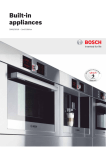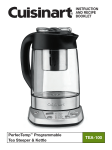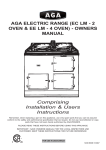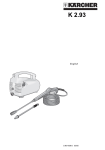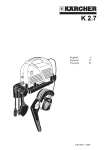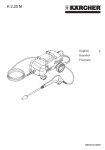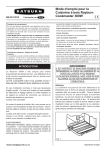Download Cooking appliances - E-Book
Transcript
9 Cooking appliances Cooking appliances can be broadly categorised as follows: freestanding cooker range cooker built-in, split-level oven and hob microwave oven Freestanding cookers Freestanding cookers combine an oven, grill and hob in one unit. They are generally cheaper and take up less room than either range cookers or built-in separate ovens and hobs. Unfortunate visual result of fixing a freestanding cooker in with standard cabinets by breaking the plinth line 98 Architect’s Pocket Book of Kitchen Design Their disadvantage is that, when slotted into a countertop, there are inevitable gaps on either side for dirt to accumulate and paper thin items to disappear. They break up the run of cabinets visually as the worktop and plinth boards are not continuous. A few freestanding cookers still have high level grills which are often popular but inhibit any storage above them for at least 300 mm and make a cooker hooded fan over the hob impracticable. The oven is always at low level which is more difficult for easy access and visibility than an oven at waist level. Most have depths of 600 mm to suit a standard worktop. Common widths are 500, 600 and 630 mm. Traditional range cookers Range cookers with their cast iron construction and brightly coloured enamel doors have, for a long time, been a musthave item for the leisured classes in country houses. As they can cost as much as a new car and are expensive to run, they are inevitably a status symbol. They are disliked by professional cooks for their lack of flexibility and unreliable oven and hob temperatures. They are also not a good choice for busy working people – there is no thrusting two chops under a grill for a quick supper. If the insulated lids are left up for some time, the burners will cool down and take some time to regain heat. Ideally they are ‘on’ all the time as cooling down causes condensation which results in rust. However, despite all these disadvantages, they are loved by their owners for their comfortable room-warming properties and small details like the full length front rail for drying towels and overnight slow cooking in the bottom oven. There are several different models: cooking only, cooking with a back boiler for hot water, cooking with a larger boiler for hot water and central heating for a limited number of radiators. Cooking appliances 99 Typically there are two oven and four oven types, approximately 1 m and 1.5 m wide. All models have at least a main oven and a second warming oven with two cast iron hot plates with insulated lids, one for boiling and one for simmering. Insulating lids Simmering plate Boiling plate Burner unit Roasting and baking oven Simmering oven Two oven AGA cooker c. 1985 The depth is generally well over 600 mm so will protrude from a standard worktop and depending on type, some models require a 150 mm gap at one side for servicing and a 50 mm gap if positioned next to combustible materials such as a kitchen cabinet. 100 Architect’s Pocket Book of Kitchen Design An electricity supply will be needed for those models with a pump and oven timer. There are different models for the following fuels: natural or propane gas, electricity, kerosene, smokeless or bituminous coal, wood and peat briquettes. They must sit on a concrete hearth of at least 125 mm thickness and all need an appropriate flue, except for electric models which need a vent to the outside air. Source: Aga-Rayburn New range cooker with gas hob, electric griddle and ovens with splashback and chimney cooker hood all in stainless steel – by Smeg Cooking appliances 101 New range cookers More recently, a modern version of the traditional range cooker has been developed which also has become a status symbol and a mark of the serious cook as they have 6–8 burners rather than 4 on a standard split-level hob and have either one very large oven or a medium oven with a smaller oven alongside. Some models also have warming and/or storage drawers. They are generally 600 mm deep, so can align with standard worktops and come in 900, 1000, 1100 and 1200 mm widths. Most are dual-fuel, gas hobs and electric ovens with integral grills. Some are all-electric or all-gas. They look stylish generally finished in brushed stainless steel with cast iron griddles. Others are available in enamelled steel. Apart from larger cooking areas, they do not perform any better than freestanding or split-level cookers. Built-in ovens and hobs Built-in, split-level ovens and hobs can be positioned in different parts of the kitchen or be fixed one above the other. Hobs can be inset anywhere in a worktop as their height is seldom more than 40 mm so do not interfere with drawers or cupboards underneath. Ovens can be positioned at waist level in tall cabinets or fitted under a countertop wherever required. They are more expensive than freestanding cookers, not least because a cabinet housing will be needed for the oven. There is also the opportunity to have different fuels for the two components. The perceived wisdom is that the best combination is a gas hob for instant and visible ease of adjusting the heat source and an electric oven which can be more precisely controlled and is slightly easier to keep clean. 102 Architect’s Pocket Book of Kitchen Design Ovens – built-in Individual ovens must have a grilling facility. Where there is only one oven, this will preclude roasting at the same time as grilling. Therefore two ovens are preferable – the second oven could in fact be a separate microwave oven with an integral grill. See p. 109. The following features are desirable: large glass viewing panel in the oven door oven light rotisserie – a revolving spindle for spit roasting oven cleaning system (see below). Ovens may have side-hung or drop-down doors. Both have advantages. Side-hung doors do not get in the way and make for easier access. Drop-down doors provide a useful shelf for heavy vessels prior to moving them for serving. Front panel finishes can be: enamelled steel, stainless steel or aluminium. 1620 1320 0870 0720 0270 0150 0000 Typical heights of built-in single and double ovens Cooking appliances 600 mm wide SS multifunction single oven – by Candy 900 mm wide SS multifunction single oven with meat probe – by AEG 103 600 mm wide polished SS multifunction double oven by Smeg 600 mm wide gas oven and grill – by New World 600 mm wide ‘Compact’ (i.e. low) single ovens available in various formats: self-cleaning multi-function oven, multi-function oven, steam oven, microwave oven which can be combined with one another or with standard size ovens according to choice – by Atag Built-in electric and gas ovens 104 Architect’s Pocket Book of Kitchen Design Microwave oven with trim for building into a 600 mm wide 320 mm deep wall unit – by Neff Freestanding combination microwave oven with grill by Baumatic Steam oven for 600 mm wide unit by Miele Steam oven shown with the water reservoir partly removed by Atag Warming drawer (under oven) 140 mm high – by Gaggenau Warming drawer 290 mm high – by Bosch Built-in microwave, steam ovens and warming drawers Cooking appliances 105 Electric oven types Most electric ovens come with a variety of functions and are often described as ‘multi-function’. The basic types are described below: conventional fan oven grilling fan grilling bottom heat defrosting top and bottom elements for radiant heat cooking. fan at rear circulates, reducing the need for pre-heating, so saves time and can reduce cooking time. radiant heat from top element, some ovens have a half grill option for smaller portions. alternating between full grill and fan for a spit-roast effect. bottom element only for a crisp underside for pizza and pastry bases. fan circulates air to speed up thawing. These functions sometimes have proprietary names which can make comparing the merits of different ovens more difficult. There are also even more sophisticated variations of using these functions. Steam ovens The steam oven is the latest method of electric cooking. The advantages of cooking with steam is that as the temperature never exceeds 100°C and as the food is not immersed in water, minerals and flavours are retained and protein can neither coagulate nor be lost through seepage, so that fish and meat stay tender and juicy. Also, nothing can burn or boil over so the oven is much easier to keep clean. Steam cooking is also useful for bottling fruit, sterilising, melting chocolate and mulling wine. 106 Architect’s Pocket Book of Kitchen Design In most types, no water supply is necessary as the steam comes from a reservoir which must be filled with (tap) water for every cooking session. The condensate is collected in a tray at the bottom which has to be emptied after cooking. More sophisticated models are available which can be connected to the water and drain pipes. A limescale indicator will show when the descaling programme needs activating. These ovens are equipped with racks and trays so that a variety of meat, fish and vegetables can be cooked simultaneously. Note that steam comes out of the oven when the door is opened and therefore it is not considered safe to build them in under worktop level as they could scald children. Warming drawers Warming drawers are designed to pre-heat and keep food and plates warm in a drawer heated at 30–80°C. The drawer(s) are usually stacked below the oven. Gas ovens Gas ovens are far simpler than electric ovens as the different heating zones are determined by the setting of the thermostat which corresponds to the central shelf while the top shelf is one gas mark above, the bottom shelf one gas mark below and the bottom of the oven still cooler. Some cooks prefer to bake in a gas oven rather than an electric oven as the hot air is more moist. The grill is incorporated in the top of a single oven or in a separate smaller oven. Built-in gas ovens are few and far between and tend only to be made by British manufacturers. Cooking appliances 107 Oven cleaning systems Pyrolytic cleaning works by heating the oven up to around 480°C for 1–3 hours which reduces food deposits to ash which can be swept away when the oven is cool. Oxylytic linings are made up of microscopic porous oxygenfilled ceramic spheres. When the oven is heated up, oxygen is released causing food deposits to oxidise. Catalytic liners are coated with a rough surfaced vitreous enamel that is activated by heating the oven to 220°C for half an hour which speeds up the process of burning off deposits. Hydro-clean is a method of cleaning the oven by pouring 400 ml water and some detergent into the base of the oven and operating the bottom heating element to 60°C. This produces steam to loosen deposits which can be wiped out with a damp cloth when the oven is cool. Enamel linings are sometimes provided at the bottom of the oven and also at the top of the oven which are removable for easier cleaning. Microwave ovens Microwave ovens, in one form or another are an essential appliance in today’s kitchen. They may only be used for minor tasks such as defrosting, warming plates or reheating food or they may be the sole oven in the kitchen when conventional cooking is combined with microwaving as in the combination microwave which allows for extra speed and efficiency. It is the essential appliance for busy young professionals working long hours who rely on ready-prepared frozen food for their evening meal. 108 Architect’s Pocket Book of Kitchen Design How microwaves work Microwaves are high frequency, short length, electromagnetic waves similar to TV radio waves. At the heart of the oven is a magnetron which converts the electric current into microfrequency waves (2450 MHz for an 850 W oven). Microwaves are reflected by metal, but can pass through most other materials. They are particularly attracted to moisture. As microwaves enter the oven, they are scattered to distribute heat evenly either by stirrers or by a turntable. They reflect off the metal walls of the oven and pass through the non-metallic containers into the food. Here they cause molecules in the food to vibrate millions of times per second producing great heat which cooks the food. Microwaves generate heat but are not hot in themselves. Food will continue to cook after being removed from the oven, not by the microwaves but by the conduction of heat within the food. This is why some dishes need a certain amount of standing time before being served. Safety Microwaves, unlike X-rays and gamma rays, are non-ionising which means they do not build up in the body and do not change the structure of body cells. As a result they do not damage food chemically or build up radiation in the oven. Should microwaves leak from the oven, say from a faulty door seal, only a small amount would escape and this would decrease rapidly with distance from the oven. Microwave ovens have to meet stringent emission criteria and the leakage level allowed is much lower than that which could cause harm. To prevent microwaves from escaping, doors are sealed electronically with at least two interlocking safety switches. This ensures the oven cannot be operated unless the door is completely closed and also that microwaves cease instantly the door is opened. Cooking appliances 109 Pros and cons of microwave cooking As microwaves cannot pass through the metal walls of the oven, they are remarkably energy efficient. Microwave ovens use only about 1 kW/h of energy as opposed to about 5 kW/h in many conventional ovens. Microwaves do not shrink meat, destroy the taste or nutritional value of the food. It is a valuable tool for quick thawing of frozen food, softening butter, melting chocolate, warming plates and heating hot drinks. However, some foods can become somewhat limp, when they should be crisp or brown. This can be remedied by choosing a microwave oven with a grill or multi-function oven. Types of microwave oven There are basically three types: microwave cooking only microwave with grill combination microwave usually small and often freestanding good for browning meat, etc. includes a grill and conventional oven elements and a fan. This provides six cooking methods: microwave only microwave plus grill microwave plus fan microwave plus grill and fan conventional oven grill only Built-in models are designed to suit 500 and 600 mm wide cabinets. Freestanding models can also sometimes be built-in with a proprietary kit. There are a few small models with a depth of 300 mm designed to be fixed under standard wall cabinets. 110 Architect’s Pocket Book of Kitchen Design Power rating The power output of most microwave ovens can be: 600, 800, 900, 950 or 1000 watts. The higher the power the faster the cooking. Some foods, however, such as those with a great deal of water, fat or sugar may curdle if cooked too fast so lower power and a longer time is needed. As a result there are different power levels which can range from 4 to 10. Normally 5 or 6 is used. These numbers relate to different functions and starting with the lowest numbers, they are used for: keeping food warm, defrosting, roasting, baking, cooking vegetables and heating liquids. Typical sizes small freestanding microwave oven: 17 litres 460 w 300 d 460 h mm large combination microwave oven: 30 litres 595 w 500 d 460 h mm Features Some or all of the following features may be included: automatic programmer sensor cooking memory timer pre-set/delayed start normal or touch controls oven will select appropriate power level and cooking time suitable for type and weight of food measures moisture level or food temperature to detect when food is cooked allows for personal programmes to be stored Cooking appliances 111 Accessories The following accessories may be included or optional extras: removable metal rack removable glass shelf build-in kit temperature probe for fixing freestanding models into cabinets plugs into internal socket and is inserted into food and desired temperature selected. When this is reached power is switched off. Useful for large joints and poultry Maintenance Metal objects other than the manufacturer’s metal racks should never be used in microwave ovens. If metal comes into contact with the oven, sparks will fly which may cause damage. It is important to keep door seals clean and replaced immediately if damaged. Vents which let out steam should be kept clean. It is particularly important for freestanding models with rear vents that they are not placed too close to a wall. Repairs should only be undertaken by a qualified microwave service engineer. 112 Architect’s Pocket Book of Kitchen Design Hobs – built-in Natural or LPG (liquid petroleum gas) i.e. bottled gas is usually the preferred fuel for hob cooking as the heat can be adjusted visually very quickly by raising or lowering the flame. Both gas and electric hobs are available in 2, 3, 4, 5 and 6 burner sizes – four burners being standard. Burners vary in size and are typically described as rapid, medium rapid and simmering. Typical sizes (mm) w d h 2 3 4 5 6 290 520 diameter 580 700 870 520 45 45 45 45 45 burner* burner burner burner burner 520 520 520 * Two burner units are often referred to as domino or modular hobs. These can be assembled in any combination of gas and electric models. See illustration on p. 116. Gas hobs Hob base plates are made in various materials: stainless steel, enamelled steel – usually white, black or brown and cast iron. Ignition can be push button or under knob where gas lights automatically when a control knob is turned on. Some models include a flame failure device which will turn off the gas supply if the flame is accidentally extinguished. A useful safety device if a hob is quite near an operable window or outside door. A common accessory is a wok stand designed for a particular burner to support the bowl-shaped bottom of a traditional wok. Most models come with an LPG conversion kit for bottled gas. Cooking appliances 900 mm wide 5 burner gas hob with central wok burner and cast iron supports – by AEG 520 mm round 3 gas burners on glass hob with cast iron pan stands by Baumatic 720 mm 5 burner gas hob in polished SS designed by Renzo Piano – by Smeg Gas hobs 113 700 mm wide 5 individual gas burners on glass hob with aluminium frame and cast iron pan stands – by Zanussi 600 mm wide 4 gas burners on glass hob with cast iron pan supports – by AEG 600 mm SS 4 burner gas hob with enamelled pan supports by Zanussi 114 Architect’s Pocket Book of Kitchen Design Electric solid plate hobs Solid plate hobs are the cheapest type of electric hob, but they are largely being superseded by ceramic and induction hobs (see below) which are more sophisticated and easier to keep clean. The element is sealed within the plate so that the heat is distributed evenly and is thermostatically controlled. A useful safety feature is an on/off warning light. Electric ceramic hobs Ceramic hobs have halogen heating zones set under black ceramic tops. They may also include one or more dual ring zones which can extend the area, if required, to accommodate larger pans or fish kettles. The zones are operated either by control knobs or touch controls. Other features available: fast cooking zone automatic cut-out sensor residual heat indicator cooking timer emergency stop child lock – cuts off the power if electricity – controls are damaged, or if a hob is left ‘on’ inadvertently it will switch off the power after a period of time. – switches off all zones at once – prevents children altering the controls. Cooking appliances 800 mm wide 6 zone ceramic hob with control knobs and residual heat indicators – by Zanussi 115 520 mm round frameless 3 zone ceramic hob with touch controls by Baumatic 914 mm wide 4 zone induction hob in bevel edged glass by Miele 320 mm wide hexagonal ceramic hobs with one hexagon as control panel which can be arranged in a variety of honeycomb patterns by Küppersbusch 600 mm wide 4 zone solid plate hob – by Zanussi Electric hobs 116 Architect’s Pocket Book of Kitchen Design 2 gas burners 2 zone ceramic Deep fat fryer Barbeque Wok gas burner SS Domino hobs – by Baumatic Electric induction hobs Induction hobs are the most expensive type of electric hob. They are more energy efficient that other types as about 75% of the energy is used to heat the pan compared with about 43% for a gas hob. The smaller the pan, the less energy is consumed. Induction hobs heat the pan by magnetic heat transmission. The act of placing a pan on a heating zone causes the coil situated below the ceramic surface to generate heat almost instantaneously. Only the area under the pan is heated – the surrounding area stays cool. Heating stops once the pan is removed. As the temperature is lower than that of standard ceramic hobs, spillages do not burn so they are easier to keep clean and safer to use. Pan Ceramic glass surface Magnetic field Inductor Electronic generator Induction cooking




















